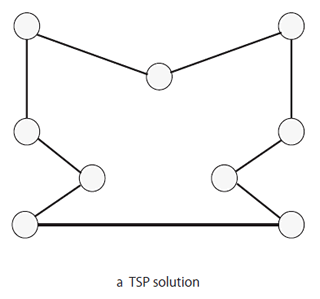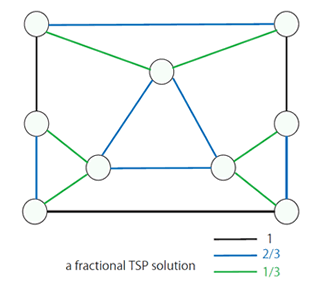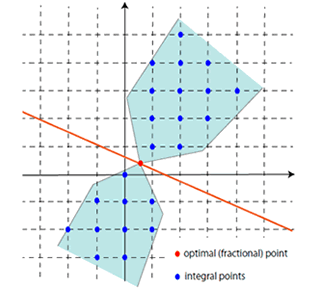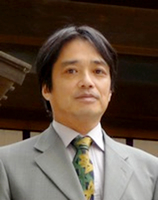
ここからコンテンツです。

Finding Near Optimal Solutions for Complex Real-world Problems
Toshihiro Fujito

Professor Fujito’s work involves designing algorithms to solve discrete optimization problems. The term “discrete” holds the opposite meaning to “continuous”, and refers to an enumerable or a finite number of things. In practical terms, its subjects range from the alignment of data to the optimization of various real world problems, such as production design, delivery routes, resource allocation, and the reliability of communication networks. Professor Fujito aims to establish a design theory of algorithms for such problems, while exploring the algorithms or methods to compute effective solutions for them.
Interview and report by Madoka Tainaka
Many real-world problems cannot be solved exactly, even with the use of high-performance computers
Professor Fujito explains that “the use of computers is essential for processing large amounts of data and for solving complex real-world problems. However, in reality, there exists a division between problems that can and cannot be easily solved using computers. When a problem is sufficiently complex, it cannot be solved, even over the course of several years, no matter how powerful the computer used. In fact, countless examples of real-world problems exist that do not yield such simple solutions. In practice, there is no alternative but to adopt a method of providing a solution that is close to the correct one, using approximations. This essentially consists of solving an optimization problem.”
Although the operating capacity of computers has improved exponentially in recent years, these kinds of problems cannot be solved by making ordinary improvements to existing computing capabilities.

A well-known classic problem is the “traveling salesman problem (TSP)”. This is the problem of finding the shortest route that a salesman can take to visit each of his target customers and return to his company. As long as the number of customers is small, this does not pose any difficulty. However, if the number of visits to be made increases to a few hundred, the number of combinations becomes very large, resulting in an enormous number of calculations. In such cases, the problem becomes unsolvable.
According to Professor Fujito, “a similar problem involves the search for the best product delivery route for convenience stores. Since the products required for each store are different, and the applicable conditions vary, calculations that are much more complex than those of the traveling salesman problem must be solved. Although some industries have already introduced computers in response to these problems, many still rely only on experience. If an optimal solution can be derived with regard to these various problems, the required cost, time, and energy can all be optimized. We have worked on the design of algorithms for such problems.”
In 2005, a group of professors from Carnegie Mellon University who drew up the game schedule for the American Major League created a sensation by significantly reducing the travel distance. Sports scheduling is beset with difficult conditions, such as the need to combine home and away games in the most unbiased manner. Nowadays, computers have been introduced in other sports as well, such as football, because they are able to contribute to the efficiency, while clearly incorporating the various conditions of optimization.
“For example, the task we are currently working on in our laboratory concerns the scheduling of nurses in a hospital. We are trying to create a work schedule that, while incorporating the shift system, provides the best possible combination of veteran and young nurses, and ensures that everyone is able to work without being burdened. Again, this is a discrete optimization problem. In this manner, we are exploring the methodology every day to derive better solutions by utilizing mathematics,” says Professor Fujito.
Formulating and adopting linear programming for NP-hard problems
The origin of the study of discrete optimization problems dates back to World War II, when “Operations Research” was successfully used. This is a research area that was embarked upon in order to improve the efficiency of “logistics,” such as the movement of military troops or distribution of supplies. One of its core techniques is that of “linear programming.”
Professor Fujito describes: “Linear programming is an algorithm that is used to tackle the problem of representing both the objective function and the constraints as linear equations, and is very effective as a framework for formulating optimization problems. Because the input and output are in a linear relationship, or in other words are proportional to each other, the problem is easy to handle mathematically, and a quick and efficient solution can be obtained.
On the other hand, optimization problems, such as the aforementioned traveling salesman problem, are said to be “NP (Non-deterministic Polynomial time) hard” problems, for which a polynomial time (realistic time) algorithm is not likely to be found, and hence they are considered to be difficult to solve. Our aim is somehow to derive an accurate solution, while knowing that this is difficult to achieve. Therefore, we have set our sights on linear programming. In other words, the difficult problem is replaced with a linear programming problem, and a reasonably accurate approximate solution is obtained.”
However, the solution obtained through linear programming is not a discrete solution. As this is a continuous solution, it must be replaced once again with a solution to the discrete optimization problem. The design of algorithms for this step is where the skills of Professor Fujito come into play. He explains


“Besides linear programming, probability theory and fields of discrete mathematics are also used as tools for the design of algorithms. The fields include graph theory, which deals with graphs consisting of sets of vertices and edges; matroids; and submodularity properties of functions,.
“As a result, quite some time ago in 1999, we designed an algorithm for the NP-hard problem of graph theory known as "the Feedback Vertex Set Problem". By using this algorithm, it became possible to obtain an approximate solution at a fast rate, within the factor of two from the minimum solution, even in the case of a large graph.
“In fact, I did not realize at first that this approach is equivalent to using the primal dual method, which is a type of linear programming. However, other researchers pointed out that this can be explained by the mechanism of the primal dual method. Since then, this paper has been cited by many researchers.”
Areas where young researchers can play an active role
Indeed, the vast experience of seasoned researchers has been indispensable, even in coming up with the idea of using linear programming to solve discrete optimization problems. However, a “spark” is also necessary, and the credit for this goes to Professor Fujito. How does this spark occur?
“Individual effort undoubtedly plays a large role in theoretical research, but there are also many occasions when ideas are generated through discussions. Collaborative work between teachers with experience and young researchers is in particular very effective. Ideas emerge from the combination of rich experience and young flexible thinking. Mathematics is an area where young researchers particularly can play an active role. Because the design of algorithms is becoming increasingly important, I would like to see more and more students becoming interested in this world of mathematics,” opines Professor Fujito.
However, not content with merely designing individual algorithms, Professor Fujito mentions that his vision is to continue to focus on the theory of designing algorithms.
Reporter's Note
Professor Fujito actually graduated from the Department of Mechanical Engineering. Being fascinated by computers, he decided to undertake his Master's in Computer Science at an American university.
“While mathematics, which is the foundation of engineering, consists of calculus, linear algebra, complex analysis, etc., the mathematics used in the field of computer science mainly consists of discrete mathematics and probability theory. Subjects such as graph theory are simple but very profound, a very interesting world,” he says, his eyes shining.
The fields of discrete mathematics and applied mathematics, although not very well known in Japan, are essential and cutting-edge fields, whether dealing with big data or on the contrary, predicting future events from small data. The studies of Professor Fujito will become increasingly relevant in this context.
References
- V. Bafna, P. Berman, T. Fujito. (1999). A 2-Approximation Algorithm for the Undirected Feedback Vertex Set Problem, SIAM Journal on Discrete Mathematics, 12, 3, 289-297.
- T. Hibi, T. Fujito. (2015). Multi-Rooted Greedy Approximation of Directed Steiner Trees with Applications, Algorithmica, doi:10.1007/s00453-015-9973-1, Published online: 12 February.
現実の複雑な問題に、最適な解を与えるために
藤戸教授が手掛けるのは、離散最適化問題を解くためのアルゴリズムの設計である。「離散」とは、連続に対応する概念で、一つ、二つ、三つと数え上げられる数や有限の数のこと。具体的には、データの整列から、生産設計、配送経路、資源配分、乗員スケジューリング、通信ネットワークの信頼性に至るまで、現実のさまざまな問題の最適化が対象となる。藤戸教授は、それらの問題に対し、効率よく解を与えるためのアルゴリズム、すなわち計算方法を探究しつつ、アルゴリズムの設計論の確立をめざしている。
現実の多くの問題は、高性能なコンピュータでも解けない
「実社会にある大量のデータや複雑な問題を解くには、コンピュータの活用が不可欠です。しかし現実には、コンピュータで解きやすい問題とそうでない問題が存在します。難しい問題となると、どんなにパワフルなコンピュータを使ったとしても、何年かかっても解くことができません。実は、実社会には、そういった容易には解くことができない問題が無数にあります。現実的には、近似的に解くことで正解に近い解を与える、という方法を取るしかない。それが最適化問題を解くということになります」と藤戸教授は説明する。
コンピュータの演算能力は現在まで、それこそ指数関数的に向上してきたが、こうした問題は、少々計算能力が上がったくらいでは太刀打ちできないのだという。

その代表的な問題として有名なのが、「巡回セールスマン問題」だ。これは、あるセールスマンが担当するすべての顧客先を1軒ずつ回って会社に戻る場合に、移動距離が一番短いルートを検索する、というもの。巡回する顧客先が数軒なら問題はないが、訪問先が数百に増えた途端、組み合わせが膨大になり、計算量が爆発して、問題を解くことができなくなる。
「同様の問題に、コンビニの商品配送ルートの探索があります。店ごとに必要な商品は違いますし、さまざまな条件も加わることから、巡回セールスマン問題よりもさらに複雑な計算を解かなければなりません。こうした問題に対して、すでにコンピュータを導入している業界もありますが、多くは経験に頼っている状態です。もし、さまざまな問題に対して最適な解が導き出せれば、コストも時間もエネルギーも大幅に効率化できるでしょう。私たちは、そのためのアルゴリズムの設計を手掛けているのです」
2005年、アメリカの大リーグでは試合のスケジューリングをカーネギーメロン大学の教授グループが作成し、移動距離を大幅に削減できたとして話題を呼んだ。スポーツのスケジューリングは、ホームゲーム、アウェイゲームをできる限り公正に組み合わせるなど、難しい条件がつきまとう。現在では、最適化によりさまざまな条件をクリアしつつ、効率化に貢献できるとして、サッカーなど他の競技でもコンピュータの導入が始まっている。
「例えば、私たちの研究室で現在取り組んでいるのは、病院のナースのスケジューリングです。交代制に対応しつつ、ベテランと若手看護士をうまく組み合わせ、皆ができるだけ負担のないように働ける勤務表を作成しています。これも離散最適化問題の一つ。このように、数学を活用することで、よりよい解を導き出すための方法論を日々、探っているのです」と藤戸教授は語る。
NP困難な問題に、線形計画法を採用して定式化する
そもそも離散最適化問題研究の端緒は、第二次世界大戦で成果をあげた「オペレーションズ・リサーチ」まで遡る。これは、軍の部隊の移動、物資の配給など「兵站」の効率化を図るために始まった研究分野で、その手法の一つに「線形計画法」がある。
「線形計画法とは、目的関数と制約条件がともに一次式で表現できる問題に対するアルゴリズムで、最適化問題を定式化できる枠組みとして大変有効です。線形、すなわち入出力が比例関係にあるため、数学的に扱いやすく、高速に効率よく問題を解くことができるのです。
一方、先述の巡回セールスマン問題のような最適化問題は、『NP(Non-deterministic Polynomial time)困難』と呼ばれ、多項式時間(現実的な時間)アルゴリズムが見つかりそうにない、解くことが困難な問題とみなされています。難しいことは承知の上で、なんとか精度のいい答えを見つけたい、というのが私たちの狙いです。そこで目をつけたのが、線形計画法でした。つまり、難しい問題を線形計画問題に置き換えて、精度のいい近似解を得ようとているのです」
ただし、線形計画法で得られた解は、離散的ではない。連続的な数のため、それをふたたび離散最適化問題の答えとして置き換えてやる必要がある。そのためのアルゴリズムの設計こそ、藤戸教授らの腕の見せ所となる。


「そのほかにも、離散数学の一分野で、頂点と辺の集合で構成されるグラフを扱うグラフ理論や、マトロイド、劣モジュラ性などといった関数に関する性質、確率論などを、アルゴリズムの設計のための道具立てとして使います。
成果としては、1999年と少々古いものになりますが、『フィードバック独立点集合問題(Feedback Vertex Set Problem)』というグラフ理論に関するNP完全問題(NP困難と同等に難しい問題)に対して、たとえグラフが大きくなったとしても、最小解の2倍以下の精度で高速に近似解を求めることができるアルゴリズムを設計しました。
実は、最初はこの手法が線形計画法の一種である主双対法を用いた手法と同等であることに気づいていなかったのです。ところが、他の研究者により、それが主双対法のメカニズムで説明できることが示されました。以後、この論文は非常に多くの研究者に引用されています」と、藤戸教授は自負する。
若い研究者が活躍できる分野
離散最適化問題の解法に線形計画法をどのように用いるかといった着想には、研究者としての経験の積み重ねが不可欠だが、一方で、「ひらめき」も欠かせないと藤戸教授。いかにして、ひらめきを呼び込むことができるのだろうか。
「理論研究の世界では、やはり個人の力が大きいと思いますが、一方で、ディスカッションの中からアイディアが生み出されることも少なくありません。なかでも、経験のある教員と若手研究者による共同作業はとても有効です。豊かな経験と若い柔軟な発想の組み合わせにより創発されるのです。とくに数学の分野は若手研究者が活躍できる分野です。アルゴリズムの設計は今後ますます重要になりますから、ぜひ、多くの学生に、この世界の面白さに触れてもらいたいですね」と、藤戸教授。
一方で、藤戸教授は、単に個々のアルゴリズムを設計するだけでなく、アルゴリズムを設計するための理論構築にも注力していきたいと展望を語った。
取材・文=田井中麻都佳
取材後記
実は工学部機械工学科出身の藤戸教授。コンピュータの魅力に取り憑かれて、修士でコンピュータサイエンス学科のあるアメリカの大学へ留学することにしたという。
「工学部で基盤となる数学は、微積や線形代数、複素解析などですが、情報科学の分野では離散数学や確率論の方が主となります。グラフ理論など、シンプルだけどとても奥が深く、非常に面白い世界です」と、目を輝かせる。
日本でこそ、離散数学や応用数学の分野はあまり知られていないが、いまやビッグデータを扱うにしろ、逆に少ないデータから将来予測をするにしろ、必要不可欠かつ最先端の分野。今後、藤戸教授の研究はますます注目されることになるだろう。
Researcher Profile

Dr. Toshihiro Fujito received his B.E. and M.E. degrees in Mechanical Engineering from Kyoto University, in 1981 and 1983, respectively. He received his M.S. and Ph.D. degrees in Computer Science from Pennsylvania State University, in 1986 and 1994, respectively.
He joined Toyohashi University of Technology in 2004 after working at Hiroshima University and Nagoya University, and has been a professor in the Department of Computer Science and Engineering since then.
His research interests include design and analysis of algorithms, discrete structures, and combinatorial optimization.
Reporter Profile

Madoka Tainaka is a freelance editor, writer and interpreter. She graduated from the Department of Law, Faculty of Law at Chuo University, Japan. She served as a chief editor of “Nature Interface” magazine, a committee for the promotion of Information and Science Technology at MEXT (Ministry of Education, Culture, Sports, Science and Technology).
ここでコンテンツ終わりです。
